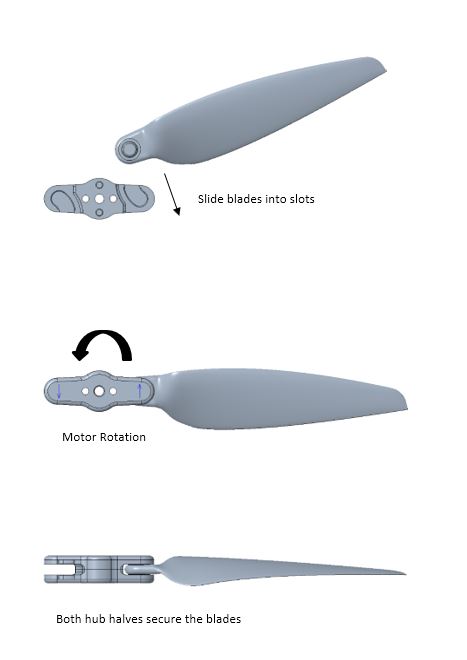APC Propeller Design Changes
(April 18, 2023)
Please note that our propeller designs may change over the years. As a result, multiple versions of the same propeller may be in circulation at any given time.
Some of these design changes may not be noticeable. However, other changes are significant and are important due to safety reasons. We will do our best to notify the general public of any changes concerning safety.
In order to verify that you have the latest design, measure the hub thickness, and compare it to that found in the product listing on our website. The measured value should be within +/- 0.010 inches.
The 16x4W is an example of a propeller that was updated in the year 2006. Older versions, with a thinner hub, are still in circulation and should not be used. Blade failure may occur.
APC Quick Release Hubs for Multi-Rotor Propellers
(June 1, 2022)
Pat. No. 10,689,103
The APC QR-HUB allows for quick removal and replacement of propeller blades without the use of tools. The blades are also free to pivot, allowing for more compact packaging.
Installation:
The QR-HUB is designed to attach directly to the motor housing using two (2) 3mm screws with 12mm spacing. The center hole is used to center the hub on a 4mm motor shaft (or shaft extension). The center hole can also be used to attached the hub to the motor. If a larger center hole is needed, use a reamer to enlarge the center hole.
The arrows on the hub indicate motor rotation. Each hub can be flipped to operate in either CW or CCW directions.
Both hub halves are used to secure the propeller blades. The blades must be installed with the leading edge oriented towards the direction of rotation.
Slide each blade completely into the slot and make sure the blade is free to pivot. The blade should be at an angle relative to the hub during installation. The slot has a restriction at the opening. As a result, a small amount of force will be needed to snap the blade in place.
Once the blades are free to pivot, they cannot fall out of the slot.
Blades should be matched with like blades. i.e. Blades with ‘A’ stamped on the lower surface should only be used with other ‘A’ blades.
Removal:
Slide each blade out of the slot. The blade should be at an angle relative to the hub for correct removal. The slot has a restriction at the opening. As a result, a small amount of force will be needed to force the blade out of the slot.
Warnings:
Do not operate motor with damaged or unmatched blades. Injury may result.
Do not operate motor with damaged hubs. Injury may result.
Do not operate motor if blades are not free to pivot.
Not recommended for systems with active rotor braking. Blades may separate from hub and cause injury.

A PDF version of these instructions can be found in the Downloads section.
APC Folding Propeller Update
(December 10, 2020)
The design of APC folding propellers has been updated to provide greater structural capability in the blade to hub transition. The new designs are still compatible with existing hub assemblies. The list of updated propellers to date is as follows:
7x4F (LP07040F)
7x6F (LP07060F)
9x5F (LP09050F)
10x6F (LP10060F)
11x8F (LP11080F)
12x8.5F (LP12085F)
13x7F (LP13070F)
13x10F (LP13010F)
14x10F (LP14010F)
The new versions have the letter ‘F’ stamped on each blade.
Weight information and other details can be found on the product information page for each propeller.
21x13.5E Replaced by 20.5x13.5EPN Propeller
(May 5, 2016)
The 20.5x13.5EPN propeller has replaced the 21x13.5E. The original 21x13.5E propeller was mislabeled and is actually a 20.5 diameter. We have corrected this labeling error and there should be no change in performance. Since some mislabeled propellers are still in circulation, you may receive a propeller with the old markings. We apologize for any inconvenience.
(LP205135EPN)
APC Self-Tightening MR Propellers
(May 1, 2015)
Several Multi-Rotor propellers sizes are now available with a self tightening feature. These propellers include a M6x1 hex nut that fits into the hub. A right hand (RH) thread is used for MR propellers and a left hand (LH) thread is used for MRP (reverse rotation) propellers. With the exception of the hub design, the blades are identical to the standard MR version propellers.
Simply insert the included nut into the hub, spin the propeller onto the motor shaft, and hand tighten. Motor shafts with both RH and LH M6x1 threads are necessary.
Aftermarket motor-to-propeller adapters compatible with APC self tightening propellers can be found at SmallPartsCNC.
Please find the currently available propeller sizes under the Self Tightening category in our online store. More sizes will be listed as they become available.
APC Multi-Rotor Propellers
(June 1, 2013)
This line of propellers is specifically designed for Multi-Rotor applications. The Multi-Rotor (MR) propellers bridge the gap between our Thin Electric propellers and Slow Flyer propellers. These propellers are lighter than the Thin Electrics and have a higher RPM capability than the Slow Flyers. RPM limits for all APC propellers can be found on the RPM Limits page.
Standard rotation and reverse rotation propellers are designated as MR and MRP, respectively.
Please find the currently available sizes under the Multi-Rotor category in our online store.
21x14E Replaced by 21x13E Propeller
(August 17, 2012)
The 21x13E propeller has replaced the 21x14E. The original 21x14E propeller was mislabeled and was actually a 21x13E. We have corrected this labeling error and there should be no change in performance. We apologize for any inconvenience.
(LP21013E)
Safety Issue Regarding 15.5x12 - 4 Blade Propeller
(August 13, 2012)
Please discontinue use of the 15.5x12 4 blade propeller on the YS170 engine. This propeller was designed for a 140 size engine and is not suitable for larger, more powerful motors. Several failures have been reported. ( LP415512)
Balancing Propellers
A significant amount of effort is put into making sure that all APC propellers are as close to being perfectly balanced as possible before they are shipped. Therefore, it is unlikely that a balance correction will be required. The following procedure should be used to check the balance of a propeller.
We recommend that the drilled hole not be used for checking balance since it is sometimes not as straight as it should be. Instead the user should check the balance of all APC propellers using the precision molded hole at the back side of the hub (see illustration below). The tapered part of the balance cone should be used on this side. A pin that is smaller than the through hole should be used to prevent any interference with the drilled hole. Finally, a washer (or the flat end of the balance cone) should be used to secure the propeller at the forward face of the hub. Similarly to the way it mounts to the motor.

If your propeller requires a balance correction, we recommend that material be removed from the upper and lower surfaces at the tip of the heavy blade. A piece of clear tape can also be added to the light blade, recommended for electric applications only.
Centering Propellers on Motor Shaft
We recommend that APC propellers be centered on the motor shaft in the manner illustrated below. The through hole should be oversized for each particular motor shaft so that only the adapter ring (locating ring) centers the propeller.

In addition to the supplied Adapter Rings (electric propellers only), aluminum tubing and/or fuel tubing can be used to center the propeller on the shaft. The standard through hole diameters for APC propellers are 3/16", 1/4", and 5/16".
Adapter Rings (LPAR18SF or LPARM12SF) can also be used to center Folding Propeller Hubs on smaller motor shafts.
Propeller Size Recommendations
APC does not make specific recommendations for propeller sizes.
Large variations exist in engine/motor performance characteristics and in model aircraft applications. Therefore, we are unable to reliably offer propeller size recommendations for specific combinations of motor type, size and application.
Please rely on written instructions/recommendations that are provided with most motors. If propeller size recommendations are not provided with the motor, please contact the motor manufacturer for suggestions.
Engine Shaft Hole Alignment
The propeller hub aft surface and aft hole are precisely defined during molding. However, post-molding shaft hole drilling may induce minor angular miss-alignment of the propeller with the engine shaft. This hole miss-alignment is avoided by use of a tapered reamer to slightly enlarge the propeller hole forward of the aft surface. This causes the propeller to precisely register with the engine shaft at the aft surface and hole.
Slow Fly and Electric Propeller Off Center Holes
The paper insert, included with slow fly and electric propellers, shows the pilot hole as the precision hole which can be used to precisely drill the non-precision hole. Our preference is to slightly enlarge the propeller center through hole using a tapered reamer from the front side of the propeller, avoiding contact with the precision hole entirely. Due to the high fiberglass content of the material used in APC propellers, we are forced to gate the material in through the center of the hub. This necessitates a second operation of drilling out the resulting sprue. For this reason, the precision locating rings were adopted for electric propeller applications.
APC Electric Pusher Propeller Configuration
The APC line of electric pusher propellers is designed for counter clockwise (CCW) rotating tractor applications. These propellers are intended for use on airplanes with twin tractor electric motors where a CCW rotating propeller may be desirable. These propellers can also be used in a true pusher application by mounting with the APC lettering facing towards the front of the aircraft.
Q40 Pylon Racing Propellers are Now Available Again
However, a new warning concerning their use is now posted below. This warning is particularly important when using higher performance Q40 engines now entering the market.
Pylon Racing Propellers Warning
A previously unobserved failure mode potentially exists when the resonant lateral frequency of the fuselage is excited by the engine rotational frequency. The failures are causing the outer portion of the tip (typically last 3/4 of an inch) to fail during flight.
This failure mode has been observed only with very limited combinations of Q40 engine, propeller, and fuselage design. We suspect that fuselage resonance, in combination with higher performance engines now entering the market, is the most probable cause for the propeller tip failures.
The initial symptoms of the failure mode are audible vibration noise in flight. The postulated mechanism has not been observed on the ground, due to the Q40 engines operating at reduced RPM until airborne.
This failure mode has, to our knowledge, has not yet caused catastrophic failure. However, the potential for more serious consequences is a concern.
Changing propeller characteristics very mildly (pitch change or diameter reduction) effectively mitigates the resonance effects. This rather strong sensitivity to propeller design clearly indicates the presence of a highly tuned resonance condition.
The observance of this new failure mode suggests that this same mechanism could occur with other combinations of fuselage stiffness (natural frequency) and engine characteristics. This might be especially true given the continuous improvements in engine performance. Therefore, the following cautions are particularly emphasized when operating higher performance pylon racing model aircraft.
CAUTIONS:
- Do not continue use of the propeller if any vibration is heard during flight.
- Discontinue use of the propeller if any stress marks are evident on the blades after use.




